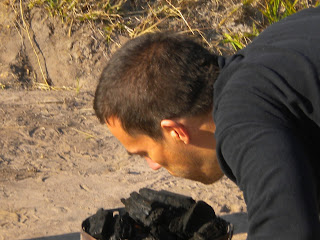We've left the Congo (more on that soon), but I have a backlog of blog posts which I'm going to try to get up in the next week or so.
Clothing

Clothing
The most common type of clothing in Lubumbashi and elsewhere
that we’ve been in DRC (and places we haven’t, judging from the wardrobes of
the MPH students, who come from all over), is “western”-style clothing. Not
cowboy-shirts-and-rodeo-pants-western, but jeans and t-shirts and skirts and heels.
Lots of this clothing came from second-hand stores in the US,
sold sometimes with the Goodwill tag still attached. This is removed before wearing, but if an
item – especially a man’s suit – is bought new, the labels are often left on to
flaunt that fact.
A few of the used T-shirts I’ve seen have particular
significance to me, and it’s odd to see them crop up so far from their original
contexts. To wit: Seattle Marathon, Ballard Boys & Girls Club (Ballard is a
neighborhood in Seattle, and I know exactly where the B&G is), Northbrook
(my sister’s old stomping ground), and Hamden (my hometown and alma mater –
complete with forest-green shirt and yellow/gold lettering). Another
incongruous thing is that clothes lose their cultural signification. Men un-ironically
wear clothes that would be considered women’s in the US. A notable example was
a wiry, contentious taxibus collector with daisy-studded flip-flops. Women and
children sometimes wear pajama tops or bottoms or, once, I even saw a satin
slip, as regular streetwear.
Though men almost always wear slacks or jeans, it’s not
uncommon to see them wearing a shirt made of pagne (big length of colorful, patterned cotton cloth), and it’s
quite common to see women wearing dresses or an outfit made of pagne. Lots of
women have both western-style clothes and pagnes and wear one style sometimes,
the other at other times. Often pagnes have religious, political, or
professional images and slogans printed on them.
I didn’t bring many clothes with me, being unsure what would
be most appropriate to wear and planning to get some things made. Initially, I
had assumed that pagnes were relatively inexpensive. Not so -- I bought a used
skirt at the local market for $10, which is not cheap, but still cheaper than
buying a pagne ($10-20-ish) and having it sewn up into an outfit. My first attempt
at getting something custom-made out of a pagne ended in disaster, with the
jacket ($45) tolerable but the skirt ($15) lamentable. Eric’s shirt ($15)
turned out well, though he’s never worn it. [Eric: I don’t want to feel like a
poser.]
I decided to try something ready-made, thinking that it
would be less expensive. One of the doctoral students, a woman around my age,
took me to a few hole-in-the-wall shops that had surprisingly nice stuff.
There’s little advertising on the street, and storefronts are often deceptively
plain, so it’s hard to judge the extent and quality of the wares from outside.
I was fascinated by
the outfits imported from West Africa made of shiny, moiré fabric called bazin, often decorated with beads or
metallic thread, and I tried a few on. I thought I’d be willing to spend $20-30
on one; my jaw hit the ground when I heard the plainest started at $100.
We went to a shop that had a variety of West African imports
at half-price. The bazin weren’t on sale,
 |
| These range in price from $250-$350 |
but I ended up with two outfits, including this one (for $75). This shopping experience re-calibrated how I saw women on the streets of Lubumbashi; lots of pricey threads out there.
 |
| The salesperson caught me with an unfortunate expression, but I was smiling inside |
The skirt was tight in the hips, and I was impressed that
the seamstress just eyeballed me and said there was no need to try on the skirt
again for her. I put it down to her incredible skill, and left the skirt in her
hands, marveling at her mastery of the art of dressmaking, nearly lost in the
US. When I tried on the altered skirt, though, it had comical huge pouches on
each side that bore no relation to any conceivable human shape. Looking at her
handiwork, the seamstress agreed that a re-do was in order; it came out better
the second time around.
As our departure approached, I started to get gifts from the
grad students I’d been giving seminars to. The first was from the Higher
Institute of Allied Health Professions; one of them invited me to her house
(after nearly 9 months in Lubumbashi, the first invitation to a Congolese
friend or colleague’s home!), and she and her colleagues presented me with this
beauty:
Then I bought a couple more pagnes and decided to try again
at a different seamstress, but again with mixed results.
Then the grad students from the School of Public Health gave
me and Eric each an outfit (and me a malachite pen holder, malachite being
abundant in Katanga Province):

Then one of the grad students with whom I’ve worked
particularly closely gave me and Eric each an outfit (no picture yet, but
I think it’s going to be on our Christmas card this year …), and the colleague
with whom I’ve worked most closely gave me a very elegant outfit.
And, finally,
the Director of the School of Public Health presented me with my very own UNILU
academic robe!
Never having owned my own robe before, I was quite tickled,
although I was a bit chagrined the next day when I attended the graduation
ceremony and realized that most professors had leopard skin trim on their
robes:
 |
| UNILU Med School grads of 2015 |
Of course, it remains to be seen whether I actually
wear any of these in Seattle.
























































